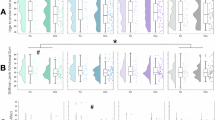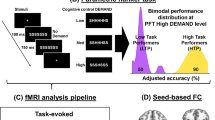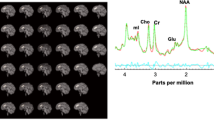Abstract
Smokers exhibit decrements in inhibitory control (IC) during withdrawal. The objective of this study was to investigate the neural basis of these effects in critical substrates of IC—right inferior frontal cortex (rIFC) and presupplementary motor area (pre-SMA). Smokers were scanned following smoking as usual and after 24-h smoking abstinence. During scanning they completed a Go/No-Go task that required inhibiting responses to infrequent STOP trials. Event-related brain activation in response to successfully inhibited STOP trials was evaluated in two regions of interest: rIFC (10 mm sphere, x=40, y=30, z=26) and pre-SMA (10 mm sphere, x=2, y=18, z=40). Smoking abstinence robustly increased errors of commission on STOP trials (37.1 vs 24.8% in the satiated condition, p<0.001) while having no effects on GO trial accuracy or reaction time (RT). In rIFC, smoking abstinence was associated with a significantly increased event-related BOLD signal (p=0.026). Pre-SMA was unaffected by smoking condition. The results of this preliminary study suggest that successful IC during withdrawal is associated with increased processing demands on a cortical center associated with attention to inhibitory signals.
Similar content being viewed by others
Log in or create a free account to read this content
Gain free access to this article, as well as selected content from this journal and more on nature.com
or
References
Aron AR, Behrens TE, Smith S, Frank MJ, Poldrack RA (2007). Triangulating a cognitive control network using diffusion-weighted magnetic resonance imaging (MRI) and functional MRI. J Neurosci 27: 3743–3752.
Aron AR, Fletcher PC, Bullmore ET, Sahakian BJ, Robbins TW (2003). Stop-signal inhibition disrupted by damage to right inferior frontal gyrus in humans. Nat Neurosci 6: 115–116.
Aron AR, Poldrack RA (2005). The cognitive neuroscience of response inhibition: relevance for genetic research in attention-deficit/hyperactivity disorder. Biol Psychiatry 57: 1285–1292.
Aron AR, Robbins TW, Poldrack RA (2004). Inhibition and the right inferior frontal cortex. Trends Cogn Sci 8: 170–177.
Azizian A, Nestor LJ, Payer D, Monterosso JR, Brody AL, London ED (2010). Smoking reduces conflict-related anterior cingulate activity in abstinent cigarette smokers performing a stroop task. Neuropsychopharmacology 35: 775–782.
Bekker EM, Bocker KB, Van Hunsel F, van den Berg MC, Kenemans JL (2005). Acute effects of nicotine on attention and response inhibition. Pharmacol Biochem Behav 82: 539–548.
Brett M, Anton J-L, Valabregue R, Poline J-B (2002). Region of interest analysis using an SPM toolbox. In 8th International Conference on Functional Mapping of the Human Brain. Sendai: Japan.
Chao HH, Luo X, Chang JL, Li CS (2009). Activation of the pre-supplementary motor area but not inferior prefrontal cortex in association with short stop signal reaction time—an intra-subject analysis. BMC Neurosci 10: 75.
Chikazoe J, Jimura K, Asari T, Yamashita K, Morimoto H, Hirose S, et al (2009). Functional dissociation in right inferior frontal cortex during performance of go/no-go task. Cereb Cortex 19: 146–152.
Corbetta M, Patel G, Shulman GL (2008). The reorienting system of the human brain: from environment to theory of mind. Neuron 58: 306–324.
Dawkins L, Powell JH, West R, Powell J, Pickering A (2007). A double-blind placebo-controlled experimental study of nicotine: II—Effects on response inhibition and executive functioning. Psychopharmacology (Berl) 190: 457–467.
Duann JR, Ide JS, Luo X, Li CS (2009). Functional connectivity delineates distinct roles of the inferior frontal cortex and presupplementary motor area in stop signal inhibition. J Neurosci 29: 10171–10179.
Fillmore MT, Rush CR (2002). Impaired inhibitory control of behavior in chronic cocaine users. Drug Alcohol Depend 66: 265–273.
Floden D, Stuss DT (2006). Inhibitory control is slowed in patients with right superior medial frontal damage. J Cogn Neurosci 18: 1843–1849.
Friston KJ, Jezzard P, Turner R (1994). Analysis of functional MRI time-series. Human Brain Mapping 1: 153–171.
Froeliger B, Gilbert DG, McClernon FJ (2009). Effects of nicotine on novelty detection and memory recognition performance: double-blind, placebo-controlled studies of smokers and nonsmokers. Psychopharmacology (Berl) 205: 625–633.
Garavan H, Hester R, Murphy K, Fassbender C, Kelly C (2006). Individual differences in the functional neuroanatomy of inhibitory control. Brain Res 1105: 130–142.
Garavan H, Ross TJ, Kaufman J, Stein EA (2003). A midline dissociation between error-processing and response-conflict monitoring. Neuroimage 20: 1132–1139.
Garavan H, Ross TJ, Murphy K, Roche RA, Stein EA (2002). Dissociable executive functions in the dynamic control of behavior: inhibition, error detection, and correction. Neuroimage 17: 1820–1829.
Garavan H, Ross TJ, Stein EA (1999). Right hemispheric dominance of inhibitory control: an event-related functional MRI study. Proc Natl Acad Sci USA 96: 8301–8306.
Gruber SA, Yurgelun-Todd DA (2005). Neuroimaging of marijuana smokers during inhibitory processing: a pilot investigation. Brain Res Cogn Brain Res 23: 107–118.
Hampshire A, Chamberlain SR, Monti MM, Duncan J, Owen AM (2010). The role of the right inferior frontal gyrus: inhibition and attentional control. Neuroimage 50: 1313–1319.
Hampshire A, Thompson R, Duncan J, Owen AM (2009). Selective tuning of the right inferior frontal gyrus during target detection. Cogn Affect Behav Neurosci 9: 103–112.
Hatsukami D, Fletcher L, Morgan S, Keenan R, Amble P (1989). The effects of varying cigarette deprivation duration on cognitive and performance tasks. J Subst Abuse 1: 407–416.
Heatherton TF, Kozlowski LT, Frecker RC, Fagerstrom KO (1991). The fagerstrom test for nicotine dependence: a revision of the fagerstrom tolerance questionnaire. Br J Addict 86: 1119–1127.
Heishman SJ, Taylor RC, Henningfield JE (1994). Nicotine and smoking: a review of effects on human performance. Experimental & Clinical Psychopharmacology 2: 345.
Hester R, Garavan H (2004). Executive dysfunction in cocaine addiction: evidence for discordant frontal, cingulate, and cerebellar activity. J Neurosci 24: 11017–11022.
Isoda M, Hikosaka O (2007). Switching from automatic to controlled action by monkey medial frontal cortex. Nat Neurosci 10: 240–248.
Jacob III P, Wilson M, Benowitz NL (1981). Improved gas chromatographic method for the determination of nicotine and cotinine in biologic fluids. J Chromatogr 222: 61–70.
Kalivas PW, Volkow ND (2005). The neural basis of addiction: a pathology of motivation and choice. Am J Psychiatry 162: 1403–1413.
Kaufman JN, Ross TJ, Stein EA, Garavan H (2003). Cingulate hypoactivity in cocaine users during a GO-NOGO task as revealed by event-related functional magnetic resonance imaging. J Neurosci 23: 7839–7843.
Konishi S, Nakajima K, Uchida I, Kikyo H, Kameyama M, Miyashita Y (1999). Common inhibitory mechanism in human inferior prefrontal cortex revealed by event-related functional MRI. Brain 122 ( Part 5): 981–991.
Koob GF, Volkow ND (2009). Neurocircuitry of addiction. Neuropsychopharmacology 35: 217–238.
Kozink RV, Lutz AM, Rose JE, Froeliger B, McClernon FJ (2010). Smoking withdrawal shifts the spatiotemporal dynamics of neurocognition. Addiction Biology (in press).
Lane SD, Cherek DR, Dougherty DM, Moeller FG (1998). Laboratory measurement of adaptive behavior change in humans with a history of substance dependence. Drug Alcohol Depend 51: 239–252.
Larrison AL, Briand KA, Sereno AB (2004). Nicotine improves antisaccade task performance without affecting prosaccades. Hum Psychopharmacol 19: 409–419.
Levin ED, McClernon FJ, Rezvani AH (2006). Nicotinic effects on cognitive function: behavioral characterization, pharmacological specification, and anatomic localization. Psychopharmacology (Berl) 184: 523–539.
Li CS, Huang C, Yan P, Bhagwagar Z, Milivojevic V, Sinha R (2008). Neural correlates of impulse control during stop signal inhibition in cocaine-dependent men. Neuropsychopharmacology 33: 1798–1806.
Linden DE, Prvulovic D, Formisano E, Vollinger M, Zanella FE, Goebel R et al (1999). The functional neuroanatomy of target detection: an fMRI study of visual and auditory oddball tasks. Cereb Cortex 9: 815–823.
Maldjian JA, Laurienti PJ, Burdette JH (2004). Precentral gyrus discrepancy in electronic versions of the Talairach atlas. NeuroImage 21: 450.
Maldjian JA, Laurienti PJ, Kraft RA, Burdette JH (2003). An automated method for neuroanatomic and cytoarchitectonic atlas-based interrogation of fMRI data sets. NeuroImage 19: 1233.
McClernon FJ, Gilbert DG (2004). Human functional neuroimaging in nicotine and tobacco research: basics, background, and beyond. Nicotine Tob Res 6: 941–959.
McClernon FJ, Kollins SH, Lutz AM, Fitzgerald DP, Murray DW, Redman C et al (2008). Effects of smoking abstinence on adult smokers with and without attention deficit hyperactivity disorder: results of a preliminary study. Psychopharmacology (Berl) 197: 95–105.
McClernon FJ, Kozink RV, Lutz AM, Rose JE (2009). 24-h smoking abstinence potentiates fMRI-BOLD activation to smoking cues in cerebral cortex and dorsal striatum. Psychopharmacology (Berl) 204: 25–35.
Mostofsky SH, Schafer JG, Abrams MT, Goldberg MC, Flower AA, Boyce A et al (2003). fMRI evidence that the neural basis of response inhibition is task-dependent. Brain Res Cogn Brain Res 17: 419–430.
Pettiford J, Kozink RV, Lutz AM, Kollins SH, Rose JE, McClernon FJ (2007). Increases in impulsivity following smoking abstinence are related to baseline nicotine intake and boredom susceptibility. Addict Behav 32: 2351–2357.
Powell J, Dawkins L, Davis RE (2002). Smoking, reward responsiveness, and response inhibition: tests of an incentive motivational model. Biol Psychiatry 51: 151–163.
Powell JH, Pickering AD, Dawkins L, West R, Powell JF (2004). Cognitive and psychological correlates of smoking abstinence, and predictors of successful cessation. Addict Behav 29: 1407–1426.
Roberts GM, Garavan H (2010). Evidence of increased activation underlying cognitive control in ecstasy and cannabis users. Neuroimage 52: 429–435.
Sharp DJ, Bonnelle V, De Boissezon X, Beckmann CF, James SG, Patel MC et al (2010). Distinct frontal systems for response inhibition, attentional capture, and error processing. Proc Natl Acad Sci USA 107: 6106–6111.
Simmonds DJ, Pekar JJ, Mostofsky SH (2008). Meta-analysis of Go/No-go tasks demonstrating that fMRI activation associated with response inhibition is task-dependent. Neuropsychologia 46: 224–232.
Spinella M (2002). Correlations between orbitofrontal dysfunction and tobacco smoking. Addict Biol 7: 381–384.
Tapert SF, Schweinsburg AD, Drummond SP, Paulus MP, Brown SA, Yang TT et al (2007). Functional MRI of inhibitory processing in abstinent adolescent marijuana users. Psychopharmacology (Berl) 194: 173–183.
Thiel CM, Fink GR (2008). Effects of the cholinergic agonist nicotine on reorienting of visual spatial attention and top-down attentional control. Neuroscience 152: 381–390.
Verbruggen F, Aron AR, Stevens MA, Chambers CD (2010). Theta burst stimulation dissociates attention and action updating in human inferior frontal cortex. Proc Natl Acad Sci USA 107: 13966–13971.
Vossel S, Thiel CM, Fink GR (2008). Behavioral and neural effects of nicotine on visuospatial attentional reorienting in non-smoking subjects. Neuropsychopharmacology 33: 731–738.
Xue G, Aron AR, Poldrack RA (2008). Common neural substrates for inhibition of spoken and manual responses. Cereb Cortex 18: 1923–1932.
Zack M, Belsito L, Scher R, Eissenberg T, Corrigall WA (2001). Effects of abstinence and smoking on information processing in adolescent smokers. Psychopharmacology (Berl) 153: 249–257.
Acknowledgements
We thank Avery Lutz, Natalie Goutkin, and Luke Pool for their assistance with data acquisition. This research was supported by NIDA Grant K23DA017261 to FJM, NIDA Grant K24DA023464 to SHK, and by an unrestricted research grant from Philip Morris USA (Dr Jed E. Rose, PI).
Author information
Authors and Affiliations
Corresponding author
Ethics declarations
Competing interests
Ms Kozink reports no conflict of interest. Dr Kollins has received research funding and/or consulting fees from Shire Pharmaceuticals, Otsuka Pharmaceuticals, Supernus Pharmaceuticals, and from the National Institute on Drug Abuse. Dr McClernon reports having research funding from the National Institute on Drug Abuse and the Atkins Foundation; and salary support from an unrestricted grant from Philip Morris USA (Dr Jed E. Rose, PI).
PowerPoint slides
Rights and permissions
About this article
Cite this article
Kozink, R., Kollins, S. & McClernon, F. Smoking Withdrawal Modulates Right Inferior Frontal Cortex but not Presupplementary Motor Area Activation During Inhibitory Control. Neuropsychopharmacol 35, 2600–2606 (2010). https://doi.org/10.1038/npp.2010.154
Received:
Revised:
Accepted:
Published:
Issue date:
DOI: https://doi.org/10.1038/npp.2010.154
Keywords
This article is cited by
-
Do mindfulness-based interventions change brain function in people with substance dependence? A systematic review of the fMRI evidence
BMC Psychiatry (2023)
-
Nicotine dependence (trait) and acute nicotinic stimulation (state) modulate attention but not inhibitory control: converging fMRI evidence from Go–Nogo and Flanker tasks
Neuropsychopharmacology (2020)
-
ADHD, Smoking Withdrawal, and Inhibitory Control: Results of a Neuroimaging Study with Methylphenidate Challenge
Neuropsychopharmacology (2018)
-
Nicotine withdrawal-induced inattention is absent in alpha7 nAChR knockout mice
Psychopharmacology (2017)
-
Smoke and mirrors: The overnight abstinence paradigm as an index of disrupted cognitive function
Psychopharmacology (2016)



